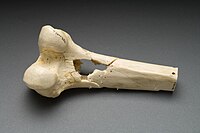Minié ball


The Minié ball (or minie ball) is a type of muzzle-loading spin-stabilising rifle bullet named after co-developer, Claude Etienne Minié, inventor of the Minié rifle. It came to prominence in the Crimean War and American Civil War.
Design
The Minié ball was a conical-cylindrical soft lead bullet, slightly smaller than the intended firearm barrel's bore, with (originally) four exterior grease-filled grooves and a conical hollow in its base. As designed by Minié, the bullet had a small iron plug in the base whose purpose was to drive forward the bullet and, under the pressure of powder gases, obturate the bullet to fill the hollow space and expand the lead skirting to grip the barrel's rifling.
The precursor to the Minié ball was created in 1848 by the French Army captains Montgomery and Henri-Gustave Delvigne. Their design was made to allow rapid muzzle loading of rifles, an innovation that brought about the widespread use of the rifle as a mass battlefield weapon. Delvigne had invented a ball that could expand upon ramming to fit the grooves of a rifle in 1826.[1] The design of the ball had been proposed in 1832 as the Cylindro-conoidal bullet by Captain John Norton,[2] but had not been adopted.
Usage
The bullet could be quickly removed from the paper cartridge with the gunpowder poured down the barrel and the bullet pressed past the muzzle rifling and any detritus from prior shots. It was then rammed home with the ramrod, which ensured that the charge was packed and the hollow base was filled with powder. When fired, the expanding gas pushed forcibly on the base of the bullet, deforming it to engage the rifling. This provided spin for accuracy, a better seal for consistent velocity and longer range, and cleaning of barrel detritus.
Effectiveness

A test in Vincennes in 1849 demonstrated that at 15 m (16.4 yards) the Minié ball was able to penetrate two boards of poplar wood, each 17 mm (2/3 inch) thick and separated by 50 cm (20 inches). Soldiers of the time spread rumors that at 1100 m (1,200 yards) the bullet could penetrate a soldier and his knapsack and still kill anyone standing behind him whilst at very close distances could kill any person in a line of 15.
History
The Minié ball only saw limited distribution in the Crimean War but later Minié-derived weapons were the most common firearm in the American Civil War. The adoption of this ammunition allowed soldiers to reload their rifled muskets faster and fire them more accurately. This increased the lethality of weapons used on the battlefield and effectively rendered conventional line infantry tactics obsolete.

The government of the United States adopted the Minié ball before the Civil War, with some changes. The skirt of the bullet base was made slightly thinner and the plug was omitted, as the pressure of the powder gas alone was sufficient to expand the skirt to engage the rifling. Also, as adopted by the U.S. Government, only three exterior grease-filled grooves were used, instead of four.
Like the musket ball, the Minié ball produced terrible wounds on those struck in battle. The large-caliber rounds easily shattered bones, and in many cases the attending surgeon simply amputated the limb rather than risk a typically fatal secondary infection. Due to the increased accuracy of rifled muskets firing these rounds, the American Civil War and to a lesser extent the Crimean war resulted in mass casualties on a larger scale than any previous conflicts.
Notes
- ^ "''The Complete Blackpowder Handbook'' by Sam Fadala p.144". Books.google.com. Retrieved 2010-05-14.
- ^ "''Of Arms and Men'' By Robert L. O'Connell p.191". Books.google.com. Retrieved 2010-05-14.
References
- Brent Nosworthy (2003). The Bloody Crucible of Courage, Fighting Methods and Combat Experience of the Civil War. Carroll and Graf Publishers. ISBN 0-7867-1147-7.
- "The lead minie ball". CivilWar@Smithsonian.

